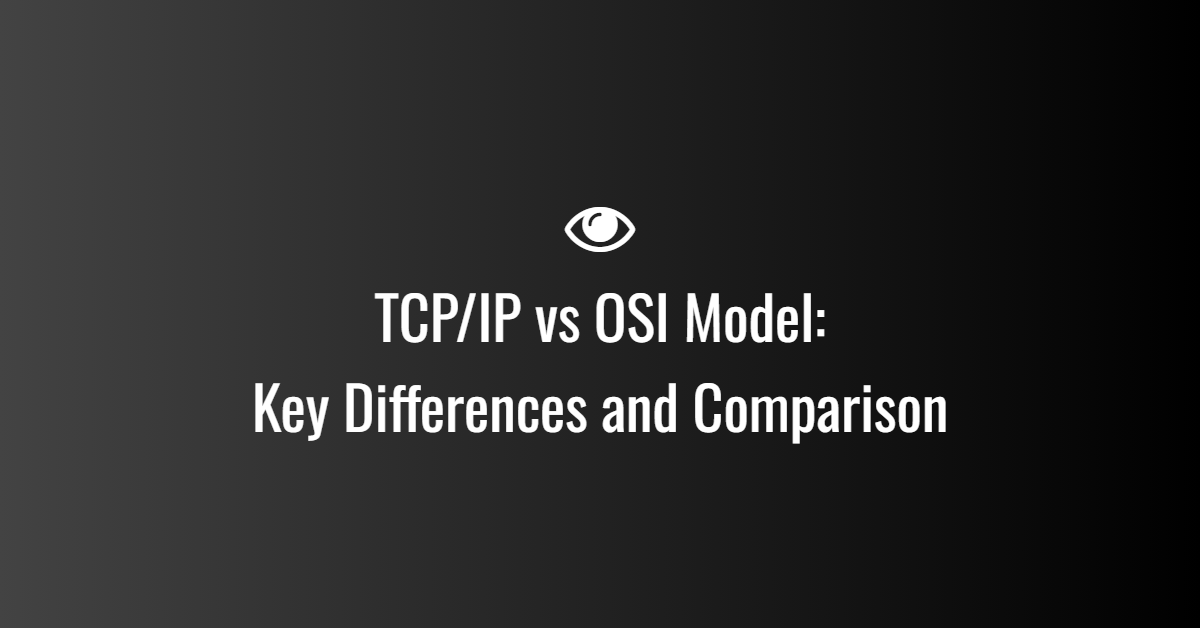
TCP/IP vs OSI Model: Key Differences and Comparison
The OSI Model and TCP/IP Model are both conceptual frameworks that describe how data travels over a network. However, they have key differences in structure, functionality, and real-world use.
1. Overview of Both Models
OSI Model (7 Layers)
- Developed by ISO (International Organization for Standardization).
- Conceptual model with 7 layers, each with a specific function.
- Used for learning and troubleshooting, but not strictly followed in real-world implementations.
TCP/IP Model (4 Layers)
- Developed by DARPA (U.S. Department of Defense).
- A practical model used in real-world networking (Internet-based communication).
- Combines OSI layers, resulting in 4 layers instead of 7.
2. Layer Comparison: OSI vs TCP/IP
| OSI Model (7 Layers) | TCP/IP Model (4 Layers) | Key Functions |
|---|---|---|
| 7. Application | Application | Handles user interaction and network services (HTTP, FTP, SMTP). |
| 6. Presentation | (Merged into Application Layer) | Data formatting, encryption, compression (SSL/TLS, JPEG). |
| 5. Session | (Merged into Application Layer) | Manages session state, authentication (NetBIOS, SIP). |
| 4. Transport | Transport | Ensures reliable or fast communication (TCP = reliable, UDP = fast). |
| 3. Network | Internet | Handles IP addressing, routing, and packet forwarding (IP, ICMP). |
| 2. Data Link | Network Access | Responsible for MAC addressing, error detection (Ethernet, Wi-Fi). |
| 1. Physical | Network Access | Physical transmission of bits (cables, radio waves). |
3. Key Differences
| Feature | OSI Model | TCP/IP Model |
|---|---|---|
| Structure | 7 layers | 4 layers |
| Real-World Use | Theoretical, mainly used for teaching | Practical, used in the Internet |
| Application Layer | Divided into Application, Presentation, and Session | Combined into one Application Layer |
| Transport Protocols | Supports any transport protocol | Focuses on TCP & UDP |
| Network Layer | Only handles routing | Includes both routing (IP) and addressing (ICMP, ARP) |
| Data Link & Physical | Separate layers | Combined into Network Access Layer |
| Developed By | ISO (International Standards Organization) | DARPA (Defense Advanced Research Projects Agency) |
4. Analogy: OSI vs TCP/IP
- OSI Model = A detailed blueprint of how networking should work.
- TCP/IP Model = A practical highway system that actually delivers packets (data) efficiently.
Example: Sending an Email
- OSI Model breaks it down into 7 steps (from formatting the email to sending it as electrical signals).
- TCP/IP Model simplifies it into 4 steps (Application → Transport → Internet → Network Access).
5. Why is TCP/IP More Commonly Used?
- Simple & Practical: Less complexity than OSI.
- Internet Standard: Used for real-world networking (e.g., web browsing, email, video streaming).
- Focuses on TCP & IP: The backbone of the modern Internet.
Conclusion
- Use OSI Model for learning & troubleshooting.
- Use TCP/IP Model for real-world networking & the Internet.



Well I sincerely liked studying it. This tip procured by you is very effective for accurate planning.
Ahaa, its good dialogue regarding this article at this place at this website, I have read all that, so at this time me also commenting here.